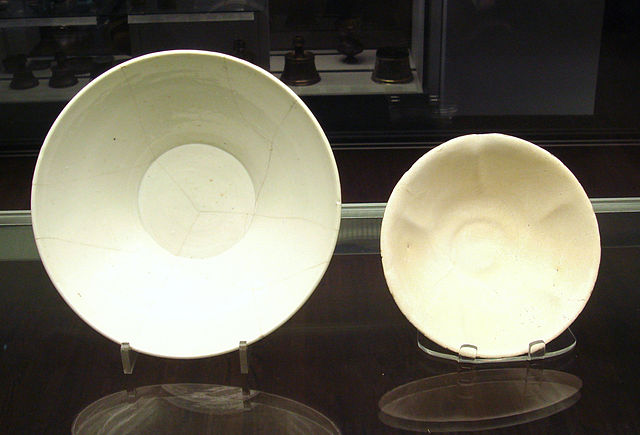Tin-glazed pottery is earthenware covered in lead glaze with added tin oxide which is white, shiny and opaque ; usually this provides a background for brightly painted decoration. It has been important in Islamic and European pottery, but very little used in East Asia. The pottery body is usually made of red or buff-colored earthenware and the white glaze imitated Chinese porcelain. The decoration on tin-glazed pottery is usually applied to the unfired glaze surface by brush with metallic oxides, commonly cobalt oxide, copper oxide, iron oxide, manganese dioxide and antimony oxide. The makers of Italian tin-glazed pottery from the late Renaissance blended oxides to produce detailed and realistic polychrome paintings.
Maiolica charger from Faenza, after which faience is named, c. 1555; Diameter 43 cm, Tin-glazed earthenware
Tin-glazed (Majolica/Maiolica) plate from Faenza, Italy
Chinese porcelain white ware bowl (left), not tin-glazed, found in Iran, and Iraqi tin-glazed earthenware bowl (right) found in Iraq, both 9-10th century, an example of Chinese influences on Islamic pottery. British Museum.
A Hispano-Moresque dish, approx 32cm diameter, with Christian monogram "IHS", decorated in cobalt blue and gold luster. Valencia, c. 1430–1500. Burrell Collection
Earthenware is glazed or unglazed nonvitreous pottery that has normally been fired below 1,200 °C (2,190 °F). Basic earthenware, often called terracotta, absorbs liquids such as water. However, earthenware can be made impervious to liquids by coating it with a ceramic glaze, and such a process is used for the great majority of modern domestic earthenware. The main other important types of pottery are porcelain, bone china, and stoneware, all fired at high enough temperatures to vitrify. End applications include tableware and decorative ware such as figurines.
Painted, incised and glazed earthenware. Dated 10th century, Iran. New York Metropolitan Museum of Art
Top section of a water jug or habb. Earthenware. Late 12th-early 13th century Iraq or Syria. Brooklyn Museum
Tea served in a kulhar, which are disposable earthenware teacups in South Asia
Terracotta flower pots with terracotta tiles in the background








